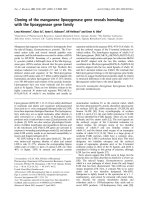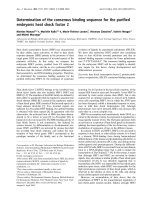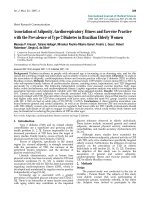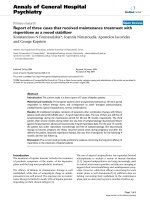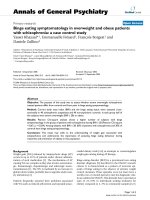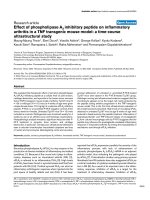Báo cáo y học: "Cost-utility of an 8-month aquatic training for women with fibromyalgia: a randomized controlled trial" ppt
Bạn đang xem bản rút gọn của tài liệu. Xem và tải ngay bản đầy đủ của tài liệu tại đây (248.11 KB, 8 trang )
Open Access
Available online />Page 1 of 8
(page number not for citation purposes)
Vol 10 No 1
Research article
Cost-utility of an 8-month aquatic training for women with
fibromyalgia: a randomized controlled trial
Narcís Gusi
1
and Pablo Tomas-Carus
2
1
Faculty of Sports Sciences, University of Extremadura, Avda. Universidad s/n, 10071 Cáceres, Spain
2
Department of Sport and Health. University of Évora, Rua de Reguengos de Monsaraz, No. 44, 7000-727 Évora, Portugal
Corresponding author: Narcís Gusi,
Received: 30 Sep 2007 Revisions requested: 14 Nov 2007 Revisions received: 7 Dec 2007 Accepted: 22 Feb 2008 Published: 22 Feb 2008
Arthritis Research & Therapy 2008, 10:R24 (doi:10.1186/ar2377)
This article is online at: />© 2008 Gusi and Tomas-Carus; licensee BioMed Central Ltd.
This is an open access article distributed under the terms of the Creative Commons Attribution License ( />),
which permits unrestricted use, distribution, and reproduction in any medium, provided the original work is properly cited.
Abstract
Introduction Physical therapy in warm water has been effective
and highly recommended for persons with fibromyalgia, but its
efficiency remains largely unknown. Should patients or health
care managers invest in this therapy? The aim of the current
study was to assess the cost-utility of adding an aquatic
exercise programme to the usual care of women with
fibromyalgia.
Methods Costs to the health care system and to society were
considered in this study that included 33 participants, randomly
assigned to the experimental group (n = 17) or a control group
(n = 16). The intervention in the experimental group consisted of
a 1-h, supervised, water-based exercise sessions, three times
per week for 8 months. The main outcome measures were the
health care costs and the number of quality-adjusted life-years
(QALYs) using the time trade-off elicitation technique from the
EuroQol EQ-5D instrument. Sensitivity analyses were
performed for variations in staff salary, number of women
attending sessions and time spent going to the pool. The cost
effectiveness acceptability curves were created using a non-
parametric bootstrap technique.
Results The mean incremental treatment costs exceeded those
for usual care per patient by € 517 for health care costs and €
1,032 for societal costs. The mean incremental QALY
associated with the intervention was 0.131 (95% CI: 0.011 to
0.290). Each QALY gained in association with the exercise
programme cost an additional € 3,947/QALY (95% CI: 1,782
to 47,000) for a health care perspective and € 7,878/QALY
(3,559 to 93,818) from a societal perspective. The curves
showed a 95% probability that the addition of the water-based
programme is a cost-effective strategy if the ceiling of inversion
is € 14,200/QALY from a health care perspective and €
28,300/QALY from a societal perspective.
Conclusion The addition of an aquatic exercise programme to
the usual care regime for fibromyalgia in women is cost effective
in terms of both health care costs and societal costs. However,
the characteristics of facilities (distance from the patients'
homes and number of patients that can be accommodated per
session) are major determinants to consider before investing in
such a programme.
Trial registration Current controlled trials ISRCTN53367487.
Introduction
Fibromyalgia (FM) is a chronic disorder of widespread pain in
combination with tenderness of at least 11 of 18 specific ten-
der points [1]. FM affects approximately 2–3% of the general
population, and more than 90% of patients are female [2-4].
The average yearly cost (updated to 2005 using a 5% annual
inflation) for service utilization among patients with FM is
approximately € 4,500, and the societal cost is € 8,960 [5].
These costs are largely due to the frequent use of medical
services such as consultations (approximately 10 per year)
and medication, and the health system and societal expenses
of disability from work [2,3]. Patients with FM consume health
care resources to a similar extent as patients with other
chronic diseases such as diabetes mellitus and hypertension
[6]. Patients with FM also incur about twice the health care
costs as the general population [7], and are absent from work
approximately twice as much as other employees [8].
Studies reported in scientific literature have demonstrated evi-
dence of the benefits of physical therapy on health-related
quality of life and fitness [9,10]. In particular, physical exercise
in warm water has been effective in short-term programmes
(less than 6 months) and is highly recommended to reduce
pain and minimize mechanical impact during exercise [11-15].
However, in our earlier study of patients with FM we found that
most of the gains in health-related quality of life and physical
fitness achieved in 12 weeks of water-based exercise were
lost after a subsequent similar period of physical inactivity
Arthritis Research & Therapy Vol 10 No 1 Gusi and Tomas-Carus
Page 2 of 8
(page number not for citation purposes)
[11,16]. These findings suggest the need for longer pro-
grammes or maintenance programmes, but the effectiveness
of such programmes remains unknown.
These programmes must be considered in light of limited
health system resources. Health system managers or deci-
sion-makers frequently select the treatment strategies based
on the lowest cost per quality-adjusted life-year (QALY). Cost
utility is the ratio of the incremental effectiveness of one strat-
egy compared to another (e.g. standard medical practice), and
is measured in QALYs divided by the incremental cost. To our
knowledge, there is no cost-utility or cost-effectiveness study
of these exercise programmes for patients with FM.
Cost-effectiveness may be studied from a health service per-
spective by including the costs to the health care system or
from a societal perspective by adding to the health care costs
those borne by the patients and society. These additional soci-
etal costs include time spent, travel costs, lost work hours, etc.
The approach from a health service perspective can help
inform decisions about adding services to the current health
care system.
The purpose of this study was to assess the cost utility of add-
ing an 8-month, supervised, warm water exercise programme
to the usual care of Public Health Service for women with FM.
Materials and methods
Recruitment
The population of the catchment area comprised women who
were in a local FM association. Eligible women were those
who had FM diagnosed by a rheumatologist in accordance
with the diagnostic criteria of the American College of Rheu-
matology (ACR) [1]. A total of 40 potentially eligible partici-
pants responded and sought further information (Figure 1).
Once the study protocol was explained, 38 people gave their
written informed consent. The following exclusion criteria were
applied: history of severe trauma, frequent migraines, periph-
eral nerve entrapment, inflammatory rheumatic diseases,
severe psychiatric illness, other diseases that prevent physical
loading, pregnancy, participation in another psychological or
physical therapy programme, or engaging in regular physical
exercise more than once a week for 30 min or longer during a
2-week period in the last 5 years. The participants in our study
of a 12-week aquatic programme [11] were excluded from the
current trial to avoid the influence of re-training. Participants'
clinical conditions were checked and a rheumatologist con-
firmed the diagnosis of FM. After excluding 5 candidates due
to their participation in other therapies, 33 female patients,
aged 37 to 71 years of age, were selected to participate. They
were randomly assigned to either the exercise group (EG; n =
17) or a control group (CG; n = 16). Two patients in the EG
failed to attend at least 95% of the treatment sessions due to
personal reasons. Nevertheless, these patients were included
in the current study to apply an intent-to-treat analysis. The trial
was exclusively developed and performed at the facilities of
the University of Extremadura, Spain, with the approval of the
Committee on Biomedical Ethics of the University and follow-
ing the updates of the Declaration of Helsinki.
Study design
A research assistant randomized participants to either the EG
or CG, according to a random number table (Table 1) and
assigned a code number to each participant. Another research
assistant, different from the one who supervised the treatment
and analyzed data, administered the questionnaires used to
gather information at baseline and after 3 and 8 months of the
programme.
Interventions
Usual care and the addition of a water-based exercise pro-
gramme were compared in the CG and EG, respectively. The
usual care included standard medical attention in the public
system (hospital and outpatient clinic including primary care)
and the social support of the local FM association. This care
could be considered the average standard of care or better for
patients with FM.
The intervention added an exercise programme in a in a waist-
high pool of warm water (33°C). A qualified exercise leader
instructed and trained the intervention group three times a
week for 1 h per session over a period of 8 months. Each ses-
sion included 10 min of warming up with slow walking and
easy movements of progressive intensity, 10 min of aerobic
exercises at 60–65% of maximal heart rate, 20 min of overall
Figure 1
Flowchart outlining participation in the treatmentFlowchart outlining participation in the treatment.
Available online />Page 3 of 8
(page number not for citation purposes)
mobility and lower limb strength exercises using water resist-
ance, another set of 10 min of aerobics at 60–65% of maximal
heart rate, and 10 min of cooling down with low intensity exer-
cises. Heart rate was monitored using a pulse meter (Polar
Accurex Plus, Kempele, Finland). During this 8-month period
participants in the control group continued their daily activities,
which did not include any form of physical exercise similar to
that in the programme. This programme was designed without
reference to any explicit behavioral model or theory, and was
intended as a pragmatic intervention that could be easily
organized for a large population.
Data collection
Participants completed questionnaires, including the EuroQol
EQ-5D health status instrument [17] at the beginning of the
programme and after 3 and 8 months. During the same period,
private and public health care was recorded, including hospital
stays, drug usage, secondary and primary care appointments.
Unit costs
The expense and time needed for travel from the patient's res-
idence to the rehabilitation pool varied, because this facility is
a scarce health resource serving a large area. To allow for a
range in such additional costs, we performed two economic
analyses, one from a health service perspective and another
from a societal perspective. The first perspective is recom-
mended by the National Institute for Clinical Excellence (NICE)
in the UK to inform decisions on health care policy for an
expensive condition. This perspective could help to decide
whether to finance the addition of the programme to the health
system. The second perspective is recommended to consider
the combination of the burden to the patient and the health
care system. The unit costs are expressed in Euros (€) based
on prices in 2005.
Costs were not adjusted or discounted for changes in cur-
rency value over time, as we focused solely on effects over
less than 1 year. The programme's cost was calculated based
on the following: salaries at the level for a university graduate,
cost of staff to run the programme, salaries at minimum wage
for the patient's time (based on the 2005 official bulletin of the
regional government), cost of renting a pool at a university at
public prices without a grant, public bus prices, and private
external management costs of the programme (insurance,
monthly retrievals from patients and withdrawals to employ-
ees). Health care prices (consultations, etc.) were based on
the 2005 official bulletin of the regional government. Drug
prices were obtained from the Spanish version of Vademecum
International [18].
Health outcomes
The EQ-5D [17] was used to assess five dimensions of health
related quality of life: (1) mobility, (2) self-care, (3) daily activi-
ties, (4) pain and discomfort, and (5) anxiety or depression.
The scale for each dimension is from 1 to 3 (with 1 no prob-
lems, 2 some problems, and 3 extreme problems). Using a
combination of these dimensions, a total of 243 possible
health states exist. Each health state has been previously
defined using the time trade-off method of utility analysis
based on the response of a sample of the Spanish population
[19]. This total score of utility was scaled from 1 = fully func-
tional quality of life to 0 = death. The quality-adjusted life years
Table 1
Socio-demographic characteristics of females with fibromyalgia at baseline
Exercise group Control group p Value
Age (years)
a
50.7 (10.6) 50.9 (6.7) 0.935
Body mass index (kg/m2)
a
28.8 (4.5) 26.6 (3.5) 0.147
Duration of symptoms (years)
a
20.1 (8.0) 19.4 (6.9) 0.791
Number of tender points (1 to 18 points)
a
16.9 (1.8) 17.2 (1.3) 0.563
Number of specific drugs (anti depressives, muscular relaxants, analgesics)
a
1.3 (0.8) 1.5 (0.8) 0.379
Employment status, n (%):
b
0.750
Blue collar 8 (53.3) 6 (40.0)
White collar 2 (13.3) 3 (20.0)
Unemployed 5 (33.3) 6 (40.0)
Education level, n:
b
0.184
Unfinished studies 1 (6.7) 1 (6.7)
Primary school 9 (60.0) 6 (40.0)
Secondary school 1 (6.7) 6 (40.0)
University degree 4 (26.7) 2 (13.3)
a
Values expressed as mean (SD), p values from analysis of variance (ANOVA);
b
p values from analysis of Chi-square.
Arthritis Research & Therapy Vol 10 No 1 Gusi and Tomas-Carus
Page 4 of 8
(page number not for citation purposes)
(QALYs) that participants experienced over the 8-month
period were estimated by calculating areas under health utility
curves [20]. To avoid bias, data were adjusted by regression
analysis for differences in baseline EQ-5D scores [21].
Cost utility analysis
First, we estimated the incremental mean costs of the water-
based programme and the mean QALYs added by the pro-
gramme from a health care and societal perspective. Sec-
ondly, the incremental cost effectiveness ratio for the water-
based programme was calculated by dividing the incremental
costs by incremental QALYs.
To report the uncertainty due to sampling variation, we calcu-
lated the 95% confidence interval using the non-parametric
bootstrapping technique (1,000 replicates re-sampled with
replacement from treatment and control populations) and plot-
ted a cost effectiveness acceptability curve [22,23]. This
curve shows the probability that the intervention is cost effec-
tive compared with the alternative, across the range of values
that decision makers are willing to pay to achieve an additional
QALY. The "investment ceiling" is the level of spending that
should not be exceeded, even assuming unlimited funding
availability. For the health care system in Spain, the 2005
adjusted investment ceiling was set at € 34,729/QALY [24].
Decision makers should compare this upper limit of accepta-
ble payment with estimated incremental cost effectiveness
ratios to determine whether a given treatment is cost effective
relative to the alternatives.
For the health system and societal perspectives, seven sensi-
tivity analyses were performed to explore the robustness of the
estimates and how dependent the results were on estimates
of participants' unit costs and efficacy. From the health system
perspective, the first analysis examined the influence of partic-
ipation rate in the programme as this could influence the pro-
ductivity by affecting the number of participants per unit of
time provided by the technician. A second analysis explored
the variations due to the salary changes of the technician,
since this is a major source of variability in economic studies
[25]. From a societal perspective, in addition to two previous
analyses the third analysis estimated the cost of increasing the
mean distance (in terms of time spent and the number of bus
tickets purchased) from the patient's residence to the rehabil-
itation pool. Finally, from both perspectives, the robustness of
cost effectiveness was examined by exploring scenarios com-
bining the influence of the variations in staff salary, rate of par-
ticipation, distance to the facility and effectiveness, from the
lowest to the highest limit of the 95% confidence interval.
Results
Costs
Table 2 shows the incremental costs, to the health care sys-
tem, and to society, of implementing the exercise programme.
The main cost was associated with renting the pool and the
difference between perspectives was mainly attributed to the
cost of time spent for travel and the intervention programme.
Table 3 shows the mean incremental cost per patient who par-
ticipated in three sessions per week in a pool with a capacity
for 20 persons. Participants in the EG and CG did not
reported changes in the number of physician consultations (1
primary care visit per month; 0.3 specialist visit per month, and
no hospitalizations). A total of 10 women in the EG and 5 in
the CG reported changes in medication. Seven women in the
EG stopped their doses of medication of amitriptyline (n = 7),
cyclobenzaprine for sleeping (n = 2) or paracetamol (n = 1).
However, two of these seven women started to take ibuprofen
and another began to take cyclobenzaprine. In the CG, three
women stopped the doses of medication (hydroaltesona, ibu-
profen and citalopram). Over the 8 months, the weekly cost of
medication increased above baseline by € 5.4 in each group
as a whole; however, no remarkable incremental costs of inter-
vention group compared to control group for medication or
consultation were observed.
Health outcome
Table 3 shows that the water-based programme was associ-
ated with a greater increase in the EQ-5D utilities than the
usual care during the first 3 months and this difference was
preserved during the subsequent 5 months.
Cost utility analysis
Table 3 shows the cost utility analyses from both perspectives.
From the health service perspective, the Spanish Health Sys-
tem Efficiency Threshold was set at € 23,153/QALY for 8
months by multiplying the published threshold of 34,729 for
12 months by 8/12 [24]. From the health service perspective,
each additional QALY gained by the exercise group cost in
average € 3,947. However, the cost effectiveness acceptabil-
ity curves (Figure 2) showed a 95% probability that the addi-
tion of the water-based programme is a cost effective strategy
if the ceiling of inversion is € 14,200/QALY and a 97.5% prob-
ability if the ceiling is set at € 21,233/QALY.
From a societal perspective, the mean cost per QALY was €
7,878/QALY and there is a 95% probability that the addition
of the aquatic training is cost effective if the ceiling of inversion
is € 28,300/QALY. A 97.5% probability requires an inversion
higher than € 42,000/QALY.
Sensitivity analysis
The sensitivity analyses are presented in Table 4. These anal-
yses showed the robustness of the conclusion that the water-
based therapy is the best alternative compared to usual care
to the variations of staff salaries and the number of participants
attended per session. Nevertheless, in the worst case sce-
nario, with a combination of minor improvements in cost utili-
ties and a low number of clients per session, warm water
exercise would be inefficient (more than € 23,000/QALY)
from both perspectives. The main source of variation was
Available online />Page 5 of 8
(page number not for citation purposes)
observed by changing the staff salaries, effectiveness in
QALYs, and the distance to the facility.
Discussion
Principal findings
Previous studies reported the efficacy of aquatic training on
patients with fibromyalgia [11-15,26,27] and the cost-utility of
a 2.5 week spa treatment [28], but to our knowledge the
present study is the first to report cost-utility. The major finding
of this study was that the water-based programme was a cost-
effective addition to usual care from both health system and
societal perspectives. More precisely, an investment in this
aquatic training for a similar population (sedentary women with
FM) has a greater than 95% probability of being efficient
according to the investment ceiling in Spain.
Strengths and weakness
The acceptable efficiency threshold, investment ceiling or
maximum willingness to pay for each gained QALY varies
among countries or societies because of differences in sala-
ries, priorities, etc. The current study applied the commonly
lower threshold of € 34,729 (€ 23,153 for 8 months) used in
the Spanish literature [24], but similar conclusions about the
efficiency of the addition of aquatic training to usual care could
be achieved using the threshold updated to year 2005 (annual
inflation of 5%) often reported in American literature ($ 50,000
to $ 60,000) or Dutch literature (€ 28,940) [29].
The retention rate of patients in the our programme (88%) was
similar to rates previously reported in community group-based
exercise programmes in fibromyalgia (70–90%); however,
aquatic training programmes usually report lower retention
rates (55–75%) [9]. The social support provided by physi-
cians, research teams, and peers with FM from the local asso-
ciation may have contributed to this high retention rate and the
improvement in the psychosocial dimensions of health related
quality of life and QALY in the exercise group. Particularly, the
patient's affiliation with the local FM association brought them
additional care (social support, information, etc.) in compari-
son to what is offered by the Public Health Care System. In
this sense, the care received by the control group could be
considered better than usual. By contrast, care that combines
the study programme with other therapies may be even better
than the programme alone. This issue could not be addressed
in the current study because patients were excluded if they
used other therapies (standardized behavioral or physical ther-
apies such as massages, etc.).
The small sample size led us to use non-parametric bootstrap-
ping techniques to treat the confidence intervals and probabil-
ity curve. Health economists recommend bootstrapping
techniques, rather than standard deviation-based methods, for
treating the uncertainty of cost-effectiveness ratios [22,23,30-
33]. The small sample, the fact that subjects were self-
selected according to bioethics requirements and the catch-
Table 2
Incremental cost of the exercise programme compared to usual care
Concept Unit
a
Over 8 months (€)Total (€)
Health system costs:
Personnel:
b
Sport technician € 9/h 1,092
Nurse € 6.5/h 788
Insurances and prevention € 350 350
Facilities (renting pool and safeguards) € 55/h 5335
Management € 24/month 192
Medication (total health system perspective)
c
Drug price 0 7,757
Additional societal costs:
Time spent in therapy € 2.15/h 3,135
Time spent in displacements and clothing € 2.15/h 3,135
Travel costs (bus tickets) € 0.5/ticket 1,455
Sub-total, societal additional costs 7,725
Total societal (additional costs and health system costs) 15,482
a
Public cost in € in 2005;
b
salary over 8 months = number of units × 13 h/month × 9.33 monthly salaries;
c
no relevant incremental costs between
groups were found. The weekly cost of medication increased € 5.4 from baseline in each group.
Arthritis Research & Therapy Vol 10 No 1 Gusi and Tomas-Carus
Page 6 of 8
(page number not for citation purposes)
ment throughout local patient associations may limit the gen-
eralization of our findings to treatment of less motivated
patients.
Use of health care
The current study did not find any evidence for decreased use
of health care services during the study period. However, the
lack of change in the ratio of frequency (consultations/month)
can be explained partially by the limits of supply and the man-
agement of free appointments in the general practices of the
National Health System in Spain. A study in a non-limited sup-
ply setting could address the question of whether an aquatic
programme could reduce the use of other health care services.
The increase in the medication cost in both groups may be
partly explained because the perception of pain is slightly
increased in the summer in persons with fibromyalgia [34];
with a change in the average temperature in Extremadura from
14°C at baseline to 22°C at the end of programme.
By contrast, the aquatic training in facilities with warm water
was a cost-effective addition to usual care but it was not
compared to other physical therapies that could reduce geo-
graphic inequalities (e.g., land-based therapies such as low-
impact aerobics, walk-based exercise, tai chi, etc.) because
their facilities are cheaper and easier available in more
municipalities.
Conclusion
An 8-month aquatic training programme is a cost-effective
addition to the usual care provided by the Public Health Sys-
tem. This programme enhances the health-related quality of
life in women with FM. However, the characteristics of facilities
(distance from patients' homes and the number of patients that
can participate per session) are major determinants that have
to be considered before a health manager decides to invest in
such a programme.
List of abbreviations
CG = control group; EG = exercise group; FM = fibromyalgia;
QALY = quality-life adjusted-years.
Competing interests
The authors declare that they have no competing interests.
Table 3
Cost-utility analyses
Alternatives Usual care Usual care plus exercise
EQ-5D utility at baseline
a
0.331 (0.150 to 0.511) 0.316 (0.162 to 0.470)
EQ-5D utility at 3 months
a
0.334 (0.175 to 0.494) 0.582 (0.434 to 0.729)
EQ-5D utility at 8 months
a
0.334 (0.175 to 0.493) 0.528 (0.380 to 0.675)
QALY over 8 months
b
0.002 (-0.087 to 0.091) 0.133 (0.034 to 0.231)
QALY difference vs. usual care
c
0.131 (0.011 to 0.290)
Health system perspective:
Incremental cost/person (€)517
Cost-utility (€/QALY)
c
3,947 (1,782 to 47,000)
Societal perspective:
Incremental cost/person (€)1,032
Cost-utility (€/QALY) ‡ 7,878 (3,559 to 93,818)
QALY, quality adjusted life year.
a
Mean (95% confidence interval) estimated by analysis of covariance with adjustment for baseline EQ-5D score and then rounded to 3 significant
figures;
b
mean (95% confidence interval) using the area under the curve technique;
c
mean (95% confidence interval estimated by bootstrapping)
using the area under the curve technique.
Figure 2
Probability curves that the addition of the aquatic training to usual care is cost-effectiveProbability curves that the addition of the aquatic training to usual care
is cost-effective.
Available online />Page 7 of 8
(page number not for citation purposes)
Authors' contributions
NG was involved in the conception, planning and design of the
study, as well as the acquisition, analysis, and interpretation of
data, and writing of the manuscript. PTC was involved in the
acquisition of data, analysis and assisting in the writing of man-
uscript. Both authors read and approved the final manuscript.
Acknowledgements
Thanks to Yolanda Garcia for her technical support as research assist-
ant. The study was supported by the European Social Funds and the
Government of Extremadura, Spain (2PR02B017 and Health
Department).
References
1. Wolfe F, Smythe HA, Yunus MB, Bennett RM, Bombardier C,
Goldenberg DL, Tugwell P, Campbell SM, Abeles M, Clark P, Fam
AG, Farber SJ, Fiechtner JJ, Franklin CM, Gatter RA, Hamaty D,
Lessard J, Lichtbroun AS, Masi AT, Mccain GA, Reynolds WJ,
Romano TJ, Russell IJ, Sheon RP: The American College of
Rheumatology 1990 Criteria for the Classification of Fibromy-
algia. Report of the Multicenter Criteria Committee. Arthritis
Rheum 1990, 33:160-172.
2. Wolfe F, Anderson J, Harkness D, Bennett RM, Caro XJ, Golden-
berg DL, Russell IJ, Yunus MB: A prospective, longitudinal, mul-
ticenter study of service utilization and costs in fibromyalgia.
Arthritis Rheum 1997, 40:1560-1570.
3. Carmona L, Ballina J, Gabriel R, Laffon A: The burden of muscu-
loskeletal diseases in the general population of Spain: results
from a national survey. Ann Rheum Dis 2001, 60:1040-1045.
4. White KP, Speechley M, Harth M, Ostbye T: The London Fibro-
myalgia Epidemiology Study: the prevalence of fibromyalgia
syndrome in London, Ontario. J Rheumatol 1999,
26:1570-1576.
5. Boonen A, van den Heuvel R, van Tubergen A, Goossens M, Sev-
erens JL, van der Heijde D, van der Linden S: Large differences
in cost of illness and wellbeing between patients with fibromy-
algia, chronic low back pain, or ankylosing spondylitis. Ann
Rheum Dis 2005, 64:396-402.
6. Doron Y, Peleg R, Peleg A, Neumann L, Buskila D: The clinical
and economic burden of fibromyalgia compared with diabetes
mellitus and hypertension among Bedouin women in the
Negev. Fam Pract 2004, 21:415-419.
Table 4
Sensitivity analyses by treatment group
Manipulation of variables Incremental cost versus usual care per person (€) Cost utility ratio
a
(€/QALY)
Health system analysis:
Number of participants per pool session:
30% lower (10 patients/group) 773 5,900
30% higher (20 patients/group) 389 2,969
Salary of personnel:
30% lower (monitor and nurse) 479 3,656
30% higher (monitor and nurse) 554 4,229
No additional salary of nurse 465 3,550
Best case scenario of salary, participation and effectiveness
b
348 1,200
Worst case scenario of salary, participation and effectiveness
v
830 75,455
Societal analysis:
Number of participants per pool session:
30% lower (10 patients/group) 1,288 9,832
30% higher (20 patients/group) 904 6,901
Salary of personnel:
30% lower (monitor and nurse) 994 7,588
30% higher (monitor and nurse) 1,069 8,160
No additional salary of nurse 980 7,481
Distance to facilities per session:
Near (without bus ticket and 1.5 h spent) 831 6,344
Far (4 bus ticket and 2.5 h spent) 1,442 11,008
Best case scenario of salary, participation, effectiveness and near
b
662 2,283
Worst case scenario of salary, participation, effectiveness and far
c
1,755 159,545
QALY, quality adjusted life year.
a
From the Spanish Health System, the cost-utility ratio threshold was set at € 23,153/QALY for 8 months in 2005;
b
pool rental + participation 20
persons per group + QALY differential at higher limit of 95% confidence interval;
c
salary 30% higher (monitor and nurse) + participation 10
persons per group + QALY differential at lower limit of 95% confidence interval.
Arthritis Research & Therapy Vol 10 No 1 Gusi and Tomas-Carus
Page 8 of 8
(page number not for citation purposes)
7. White KP, Speechley M, Harth M, Ostbye T: The London Fibro-
myalgia Epidemiology Study: direct health care costs of fibro-
myalgia syndrome in London, Canada. J Rheumatol 1999,
26:885-889.
8. Kivimaki M, Leino-Arjas P, Kaila-Kangas L, Virtanen M, Elovainio M,
Puttonen S, Keltikangas-Jarvinen L, Pentti J, Vahtera J: Increased
sickness absence among employees with fibromyalgia. Ann
Rheum Dis 2007, 66:65-69.
9. Koulil SV, Effting M, Kraaimaat FW, Lankveld WV, Helmond TV,
Cats H, van Riel P, de Jong A, Haverman J, Evers A: A review of
cognitive behaviour therapies and exercise programmes for
fibromyalgia patients: state of the art and future directions.
Ann Rheum Dis 2006. doi:10.1136/ard.2006.054692
10. Mannerkorpi K: Exercise in fibromyalgia. Curr Opin Rheumatol
2005, 17:190-194.
11. Gusi N, Tomas-Carus P, Hakkinen A, Hakkinen K, Ortega-Alonso
A: Exercise in waist-high warm water decreases pain and
improves health-related quality of life and strength in the
lower extremities in women with fibromyalgia. Arthritis Rheum
2006, 55:66-73.
12. Jentoft ES, Kvalvik AG, Mengshoel AM: Effects of pool-based
and land-based aerobic exercise on women with fibromyal-
gia/chronic widespread muscle pain. Arthritis Rheum 2001,
45:42-47.
13. Altan L, Bingol U, Aykac M, Koc Z, Yurtkuran M: Investigation of
the effects of pool-based exercise on fibromyalgia syndrome.
Rheumatol Int 2004, 24:272-277.
14. Assis MR, Silva LE, Alves AM, Pessanha AP, Valim V, Feldman D,
Neto TL, Natour J: A randomized controlled trial of deep water
running: clinical effectiveness of aquatic exercise to treat
fibromyalgia. Arthritis Rheum 2006, 55:57-65.
15. Redondo JR, Justo CM, Moraleda FV, Velayos YG, Puche JJ,
Zubero JR, Hernandez TG, Ortells LC, Pareja MA: Long-term effi-
cacy of therapy in patients with fibromyalgia: a physical exer-
cise-based program and a cognitive-behavioral approach.
Arthritis Rheum 2004, 51:184-192.
16. Tomas-Carus P, Hakkinen A, Gusi N, Leal A, Hakkinen K, Ortega-
Alonso A: Aquatic training and detraining on fitness and quality
of life in fibromyalgia. Med Sci Sports Exerc 2007,
39:1044-1050.
17. Herdman M, Badia X, Berra S: EuroQol-5D: a simple alternative
for measuring health-related quality of life in primary care.
Aten Primaria
2001, 28:425-430.
18. Vademecum [
]
19. Badia X, Roset M, Montserrat S, Herdman M, Segura A: The
Spanish version of EuroQol: a description and its applications.
European Quality of Life scale. Med Clin (Barc) 1999,
112(Suppl 1):79-85.
20. Matthews JN, Altman DG, Campbell MJ, Royston P: Analysis of
serial measurements in medical research. BMJ 1990,
300:230-235.
21. Manca A, Hawkins N, Sculpher MJ: Estimating mean QALYs in
trial-based cost-effectiveness analysis: the importance of con-
trolling for baseline utility. Health Econ 2005, 14:487-496.
22. Fenwick E, Byford S: A guide to cost-effectiveness acceptability
curves. Br J Psychiatry 2005, 187:106-108.
23. Willan AR: On the probability of cost-effectiveness using data
from randomized clinical trials. BMC Med Res Methodol 2001,
1:8.
24. Sacristan JA, Oliva J, Del Llano J, Prieto L, Pinto JL: What is an effi-
cient health technology in Spain? Gac Sanit 2002, 16:334-343.
25. Sevick MA, Dunn AL, Morrow MS, Marcus BH, Chen GJ, Blair SN:
Cost-effectiveness of lifestyle and structured exercise inter-
ventions in sedentary adults: results of project ACTIVE. Am J
Prev Med 2000, 19:1-8.
26. Mannerkorpi K, Ahlmen M, Ekdahl C: Six- and 24-month follow-
up of pool exercise therapy and education for patients with
fibromyalgia. Scand J Rheumatol 2002, 31:306-310.
27. Mannerkorpi K, Nyberg B, Ahlmen M, Ekdahl C: Pool exercise
combined with an education program for patients with fibro-
myalgia syndrome. A prospective, randomized study. J
Rheumatol 2000, 27:2473-2481.
28. Zijlstra TR, Braakman-Jansen LM, Taal E, Rasker JJ, van de Laar
MA: Cost-effectiveness of Spa treatment for fibromyalgia:
general health improvement is not for free. Rheumatology
(Oxford) 2007, 46:1454-1459.
29. van den Hout WB, Tijhuis GJ, Hazes JM, Breedveld FC, Vliet Vlie-
land TP: Cost effectiveness and cost utility analysis of multidis-
ciplinary care in patients with rheumatoid arthritis: a
randomised comparison of clinical nurse specialist care, inpa-
tient team care, and day patient team care.
Ann Rheum Dis
2003, 62:308-315.
30. Coupe VM, Veenhof C, van Tulder MW, Dekker J, Bijlsma JW, van
den Ende CH: The cost-effectiveness of behavioural graded
activity in patients with osteoarthritis of hip and/or knee. Ann
Rheum Dis 2006. doi:10.1136/ard.2006.054478
31. Briggs A, Fenn P: Confidence intervals or surfaces? Uncer-
tainty on the cost-effectiveness plane. Health Econ 1998,
7:723-740.
32. Lothgren M, Zethraeus N: Definition, interpretation and calcula-
tion of cost-effectiveness acceptability curves. Health Econ
2000, 9:623-630.
33. Epps H, Ginnelly L, Utley M, Southwood T, Gallivan S, Sculpher M,
Woo P: Is hydrotherapy cost-effective? A randomised control-
led trial of combined hydrotherapy programmes compared
with physiotherapy land techniques in children with juvenile
idiopathic arthritis. Health Technol Assess 2005, 9:iii-iv. ix-x, 1–
59.
34. Hawley DJ, Wolfe F, Lue FA, Moldofsky H: Seasonal symptom
severity in patients with rheumatic diseases: a study of 1,424
patients. J Rheumatol 2001, 28:1900-1909.



